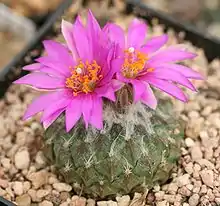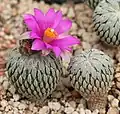Pelecyphora
Pelecyphora is a genus of cacti, comprising 2 species.[1][2] They originate from Mexico.
| Pelecyphora | |
|---|---|
 | |
| Pelecyphora strobiliformis | |
| Scientific classification | |
| Kingdom: | Plantae |
| Clade: | Tracheophytes |
| Clade: | Angiosperms |
| Clade: | Eudicots |
| Order: | Caryophyllales |
| Family: | Cactaceae |
| Subfamily: | Cactoideae |
| Tribe: | Cacteae |
| Genus: | Pelecyphora C.Ehrenb. |
| Species | |
| |
Pelecyphora is known for its medicinal properties and may have been utilized as a psychoactive in the same way as Lophophora williamsii. It is known as "Peyotillo".
Description
Pelecyphores are spherical to club-shaped stem succulents up to 6 cm in diameter and gray-green in color. They branch only sparsely and only at an older age. The areoles standing on the longitudinally or transversely flattened warts have thorns in a pectinate (comb-shaped) arrangement. As we age, the thorns, then the areoles and finally the warts fall off. Between the warts, the plant bodies are initially dense and short-haired, so that the apexes are hidden.
The flowers arise individually from short furrows on the upper surfaces of the youngest areoles. They are bright purple and about 3 cm long. The greenish fruits that form after the flowers are fertilized dry out when ripe and release the black seeds into the crown wool, from which they are only washed out (in nature) after a long time.[3]
Taxonomy
The two accepted species are:
| Image | Scientific name | Distribution |
|---|---|---|
 | P. aselliformis | San Luis Potosi, Mexico |
 | P. strobiliformis | Nuevo Leon, San Luis Potosi, Tamaulipas states in Mexico |
Synonymy
At genus level
At species level
The following are synonyms of species now placed outside of Pelecyphora:
- Pelecyphora aselliformis var. pectinata (= Mammillaria pectinifera)
- Pelecyphora pectinata (= Mammillaria pectinifera)
- Pelecyphora pseudopectinata (= Turbinicarpus pseudopectinatus)
- Pelecyphora valdeziana (= Turbinicarpus valdezianus)
- Pelecyphora plumosa (= Turbinicarpus valdezianus)
- Pelecyphora pulcherrima (= Turbinicarpus pseudopectinatus)
Psychoactivity
- Pelecyphora aselliformis: Mescaline (Less than 0.00002% in dry weight) Neal et al. 1972
Conservation status
Both P. aselliformis and P. strobiliformis are classified as being of Least Concern on the IUCN Red List, however both species are contained in Appendix 1 of CITES species (Convention on International Trade in Endangered Species) as at June 2013.
References
- Sánchez, Daniel; Vázquez-Benítez, Balbina; Vázquez-Sánchez, Monserrat; Aquino, David; Arias, Salvador (2022-01-21). "Phylogenetic relationships in Coryphantha and implications on Pelecyphora and Escobaria (Cacteae, Cactoideae, Cactaceae)". PhytoKeys. 188: 115–165. doi:10.3897/phytokeys.188.75739. ISSN 1314-2003. PMC 8799629. PMID 35106054.
- Neal, J. M.; Sato, P. T.; Howald, W. N.; McLaughlin, J. L. (1972-06-09). "Peyote Alkaloids: Identification in the Mexican Cactus Pelecyphora aselliformis Ehrenberg". Science. 176 (4039): 1131–1133. doi:10.1126/science.176.4039.1131. ISSN 0036-8075.
- Anderson, Edward F.; Eggli, Urs (2005). Das grosse Kakteen-Lexikon (in German). Stuttgart (Hohenheim): Ulmer. p. 520–522. ISBN 3-8001-4573-1.
![]() Media related to Pelecyphora at Wikimedia Commons
Media related to Pelecyphora at Wikimedia Commons